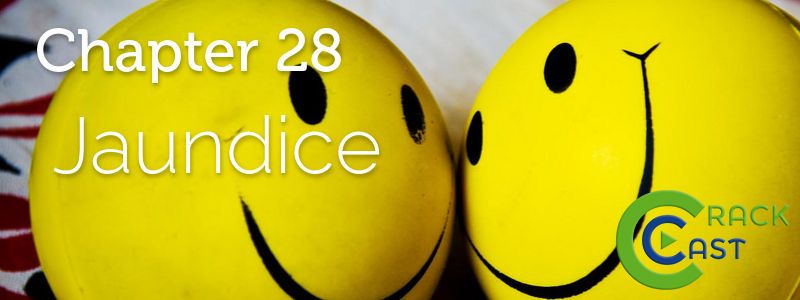This episode of CRACKCast covers Rosen’s Chapter 28, Jaundice.
Show Notes – Link HERE
[bg_faq_start]1) Describe heme metabolism
Jaundice = elevated serum bilirubin
Conjugated bilirubin = direct bilirubin
Unconjugated bilirubin = indirect bilirubin (can cross blood brain barrier) – does not bind albumin
- unconjugated levels of bilirubin that is not bound to albumin is able to cross the blood-brain barrier and leads to adverse neurologic effects
- developmental abnormalities, encephalopathy, death
- is exacerbated by any condition that leads to increased heme production or a process that competitively decreases albumin/binds to albumin (e.g. drugs or cirrhosis)
- conjugated bilirubin in contrast is non-toxic
Total bilirubin = direct + indirect
Normal bilirubin metabolism:
- heme products (red blood cells) breaking down → bilirubin
- very small portion of bilirubin comes from myoglobin (muscles) or maturing erythroid cells
- heme products are oxidied into biliverdin → bilirubin
- bilirubin binds to albumin, then is glucuronidated into the conjugated form in hepatocytes
- conjugated bilirubin is excreted into the biliary system and emptied in the gut
- colonic bacteria metabolize most conjugated bilirubin to urobilogen and stercobilin
- stercobilin is excreted into the stool
- urobilinogen is reabsorbed and is excreted into the urine
- remaining conjugated bilirubin is de-conjugated and re-enters the portal circulation to be taken up again by hepatocytes
- this completes the entero-hepatic circulation of bilirubin
Abnormal Bilirubin Metabolism
Jaundice – usually not obvious until >25 mg/L
- seen in tissues with high albumin concentrations
- skin, eyes,
- absent in tears, saliva
Three pathologic processes leading to elevated bilirubin:
- Overproduction – high levels of heme production
- hemolysis
- hypoalbuminemia
- acidemia
- drugs (bind competitively to albumin )
- Failure of conjugation – hepatocytes unable to take up, conjugate and excrete bilirubin
- hepatocellular dysfunction
- Decreased clearance
- biliary excretion problem[bg_faq_end]
2) List common pre-hepatic/hepatic/post-hepatic causes of jaundice
Three pathologic processes leading to elevated bilirubin:
- Overproduction – high levels of heme production
- hemolysis
- hypoalbuminemia
- acidemia
- drugs (bind competitively to albumin )
- Failure of conjugation – hepatocytes unable to take up, conjugate and excrete bilirubin
- hepatocellular dysfunction
- Toxins
- Tylenol, ETOH
- Vascular:
- Budd-Chiari
- Inflammatory/ Infectious
- Viral – Hepatitis
- Autoimmune
- Pregnancy related: HELLP / acute fatty liver
- Toxins
- hepatocellular dysfunction
- Decreased clearance –
- biliary excretion problem
- Gallstone disease : CBD stone, ascending cholangitis[bg_faq_end]
- biliary excretion problem
Wisecracks:
[bg_faq_start]1) What are clinical signs of liver disease?
Abnormalities in bilirubin metabolism:
- Jaundice – usually not obvious until >25 mg/L
- seen in tissues with high albumin concentrations:
- skin, eyes,
- absent in tears, saliva
- seen in tissues with high albumin concentrations:
Symptoms:
- May be asymptomatic or have:
- pruritus, malaise, nausea
- Jaundice with abdominal pain = biliary obstruction or hepatic inflammation
- Jaundice WITHOUT abdominal pain = pancreatic neoplasm
- Ask about fit of clothing (ascites) or personality changes
Signs:
- Skin
- Sublingual or conjunctival jaundice
- Signs of liver disease:
- angiomas, excoriations, caput medusae, ascites, liver borders and texture, splenomegaly, neurologic examination, asterixis
- Stages of encephalopathy – see table in Rosen’s[bg_faq_end]
2) What laboratory tests can be useful in a jaundiced patient?
- GGT = confirms a hepatic source of ALP if ALP is up
- ALP can also be elevated from bone or placental sources
- An elevated reticulocyte count can suggest hemolysis
- Acetaminophen level*** (AST is first to rise)
- Glucose level
- Ammonia level – is of limited use and does NOT correlate with degrees of hepatic encephalopathy
- Ascitic fluid – for analysis
- Blood cultures – for fever
- INR , PTT
- AST, ALT[bg_faq_end]
3) List the triad of acute hepatic failure
- Jaundice
- Encephalopathy
- Coagulopathy (INR > 1.5)[bg_faq_end]
4) List and describe 6 critical causes of jaundice
- Hepatic
- Fulminant hepatic failure
- Toxin
- Virus
- Alcohol
- Ischemic insult
- Reye’s syndrome
- Biliary
- Cholangitis (ascending infectious)
- Systemic
- Sepsis
- Heatstroke
- Cardiovascular
- Obstructing AAA
- Budd-Chiari syndrome
- Severe congestive heart failure
- Heme-oncologic
- Transfusion reaction (hemolysis)
- Reproductive
- Pre-eclampsia or HELLP syndrome
- Acute fatty liver of pregnancy
Empirical management
- Depends on the cause of jaundice and problem:
- Bleeding (in the context of coagulopathy)
- Transfuse PRBC’s and FFP
- Spontaneous bacterial peritonitis
- >250 PMN’s per cm3 of ascitic fluid
- IV ceftriaxone
- Acetaminophen toxicity:
- N-acetylcysteine
- Ascending cholangitis
- Antibiotics
- ***need acute biliary drainage in 24-48 hrs because most antibiotics are excreted***
- Choledocolithiasis or strictures
- Need for ERCP
- ***neither CT or U/S is 100% sensitive for choledocolithasis, but a dilated CBD highly suggests obstruction***
- Immune-mediated hemolytic anemia:
- Transfuse only if unable to oxygenate and in discussion with hematology
- Remove any potential offending drugs in the case of G6PD[bg_faq_end]
- >250 PMN’s per cm3 of ascitic fluid
- Bleeding (in the context of coagulopathy)
5) What are 3 causes of jaundice in pregnancy?
- Pregnancy and jaundice = pathology
- Potential causes:
- 1) hyperemesis gravidarum
- In the first trimester – ?poor nutrition and impaired bilirubin excretion
- Can have VERY high transaminases (20x ULN)
- Trxt: fluids and antiemetics and admission if biochemically deranged
- 2) acute fatty liver of pregnancy
- In the 3rd trimester
- Due to microvascular fat accumulation in the liver
- S+s:
- Nausea, vomiting, anorexia, jaundice
- May progress to fulminant hepatic failure
- Trxt: delivery, patients may need liver transplant!
- 3) intrahepatic cholestasis of pregnancy
- Idiopathic cause of jaundice in 2-3rd trimester
- S+s:
- Pruritis – trunk, extremities, palms, soles.
- Acholic stools and dark urine
- Increased risk of preterm labour or early fetal demise intra-uterine.
- Trxt:
- Ursodiol, cholestyramine
- Vitamin K[bg_faq_end]
This post was copyedited by Rob Carey (@_RobCarey)


